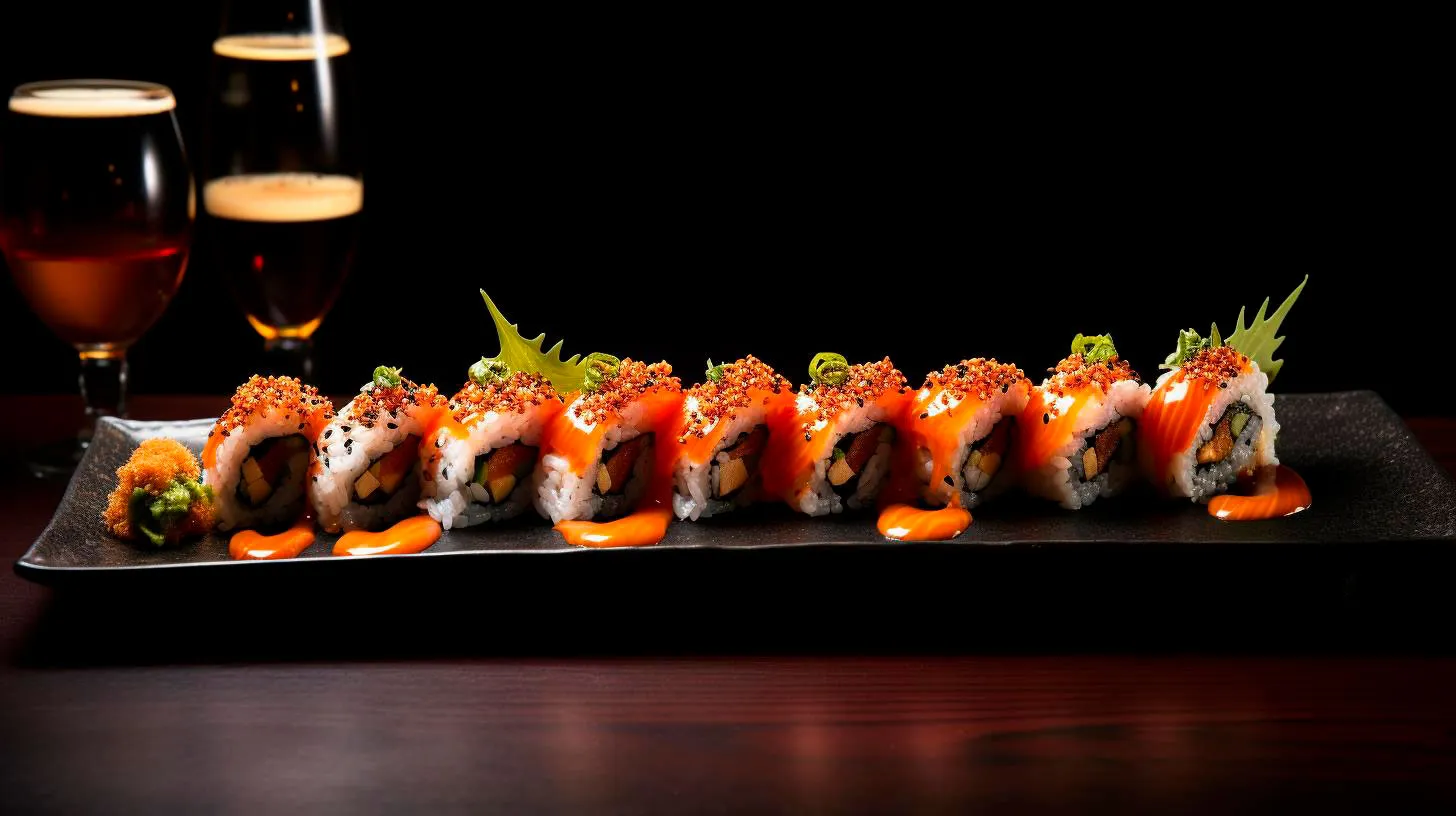Sushi Allergens Precautionary Measures for Staff and Customers
With several common allergens present in many sushi ingredients, it is crucial for both staff and customers to be aware of the potential risks and take necessary precautions to ensure a safe dining experience.
Understanding Sushi Allergens
Sushi incorporates various ingredients that may contain allergens. The most common allergenic ingredients found in sushi include:
- Seafood: Many sushi rolls and nigiri contain fish and shellfish, which are known allergens for some people. According to the Asthma and Allergy Foundation of America, seafood allergies affect around 7 million adults in the United States.
- Soy: Soy sauce is an integral part of sushi, and it contains soybeans. Soy allergies are also prevalent and can manifest as mild to severe reactions.
- Gluten: People with gluten intolerance or celiac disease should be cautious when consuming sushi. Soy sauce typically contains wheat, which can trigger adverse reactions.
- Sesame: Sesame seeds are often used as a garnish or seasoning in sushi. Allergic reactions to sesame seeds range from mild to severe.
Given the potential risks associated with these allergens, it is crucial for sushi restaurants to implement precautionary measures to protect both staff and customers.
Sushi Allergen Precautions for Staff
As a sushi restaurant owner or manager, it is your responsibility to ensure that your staff is well-trained and informed about allergen-related precautions. Here are some measures you can put in place:
- Educate staff: Train all staff members on food allergens, symptoms of an allergic reaction, and the importance of diligent preparation to minimize cross-contamination risks.
- Label ingredients: Clearly label all ingredients used in sushi preparation, indicating common allergens. This helps staff keep track of potential allergens and communicate effectively with customers.
- Separate utensils: Use separate utensils and cutting boards when handling different sushi ingredients to prevent cross-contamination.
- Proper storage: Store ingredients that contain allergens separately and ensure proper containers are used to avoid any accidental mix-ups.
- Regular staff communication: Encourage open communication within your team to ensure everyone remains updated on potential allergen risks and to address any concerns promptly.
Sushi Allergen Precautions for Customers
While staff precautions are essential, customers also play a vital role in taking precautions to protect themselves. Here are some steps customers can take:
- Inform staff: When making a reservation or ordering, inform the staff of any allergies or dietary restrictions. Clear communication allows them to guide you towards safe options.
- Read the menu carefully: Pay close attention to menu descriptions and inquire about potential allergens in specific dishes.
- Ask for ingredient lists: If unsure about any ingredients, don’t hesitate to ask for a detailed ingredient list. Sushi restaurants that prioritize customer safety will have this information readily available.
- Carry an epinephrine auto-injector: If you have a severe food allergy, carrying an epinephrine auto-injector prescribed by your doctor is crucial. This can save your life in case of an allergic reaction.
- Choose reputable restaurants: Research and choose sushi restaurants known for their attention to allergen precautions and customer safety.
Key Takeaways
Sushi can be a delightful dining experience for many, but it is important to be mindful of allergens and take necessary precautions. Remember the following key takeaways:
- Common sushi allergens include seafood, soy, gluten, and sesame.
- Restaurants should educate staff, separate utensils, and label ingredients to minimize risks for allergic customers.
- Customers should inform staff about allergies, read menus carefully, and ask for ingredient lists.
- Carrying an epinephrine auto-injector is advised for those with severe allergies.
- Choosing reputable sushi restaurants ensures better allergen precautions.
By following these precautionary measures, both sushi restaurant staff and customers can enjoy a worry-free dining experience. Stay informed, communicate effectively, and take necessary steps to protect against potential allergen-related risks!
Understanding Common Sushi Allergens
This article aims to shed light on common sushi allergens, their effects on the body, and how to deal with them.
Common Sushi Allergens
Sushi is typically made up of various ingredients, each carrying the potential for triggering an allergic reaction. The most common sushi allergens include:
- Shellfish: Shrimp, crab, lobster, and other shellfish are often used in sushi dishes. Individuals with shellfish allergies must be cautious when consuming sushi as even a small amount can lead to severe allergic reactions.
- Fish: Tuna, salmon, mackerel, and other types of fish commonly used in sushi can provoke allergic reactions. Fish allergies are among the most prevalent food allergies worldwide, so careful consideration is necessary for those affected.
- Soy: Soy sauce, a staple condiment in sushi, contains soybeans, which can elicit allergies, particularly among those with soy allergies. It is essential to check the ingredients and opt for alternative sauces if necessary.
- Seaweed: Nori, the seaweed used to wrap sushi rolls, may cause allergic reactions in individuals with seaweed allergies. It is advisable to opt for rice paper or soy wrap alternatives when sushi is prepared.
- Gluten: Some sushi ingredients, such as imitation crab sticks, may contain gluten. Individuals with gluten sensitivities or celiac disease should verify the ingredients and select gluten-free options.
The Effects of Sushi Allergens
When a sushi allergen comes into contact with an individual’s immune system, it may trigger an allergic reaction. Symptoms can range from mild to severe and may include:
- Itchy skin rash
- Sneezing and runny nose
- Hives or swelling
- Abdominal pain or nausea
- Shortness of breath or wheezing
- Anaphylaxis (a severe, life-threatening allergic reaction)
It is crucial to identify the allergen causing these reactions to avoid further exposure and manage symptoms effectively.
Dealing with Sushi Allergies
If you suspect an allergy to sushi or any of its ingredients, it is recommended to take the following steps:
- Consult a healthcare professional: An allergist can help identify the specific allergen causing your symptoms and provide guidance on managing sushi allergies.
- Read ingredient labels: Always carefully read labels and inquire about ingredients when dining out. This helps ensure you avoid any potential allergens and enjoy sushi without worry.
- Communicate with sushi chefs: When eating at a sushi restaurant, inform the chefs about your allergies. They can guide you towards allergen-free options or modify dishes to suit your dietary needs.
- Consider alternatives: If certain sushi ingredients trigger allergies, look for alternative options or choose vegetarian or vegetable-based sushi rolls that are less likely to contain allergens.
- Carry an epinephrine auto-injector: For individuals with severe allergies, carrying an epinephrine auto-injector, such as an EpiPen, is essential. It can quickly treat anaphylaxis, reducing the risk of life-threatening reactions.
Key Takeaways
Sushi allergies are not uncommon, and understanding common sushi allergens is crucial to ensure a safe and enjoyable dining experience. Remember the following key points:
- Common sushi allergens include shellfish, fish, soy, seaweed, and gluten.
- Allergic reactions to sushi can range from mild symptoms to severe anaphylaxis.
- Consult an allergist and read ingredient labels to manage sushi allergies effectively.
- Communicate your allergies with sushi chefs and consider alternative options.
- Individuals with severe allergies should carry an epinephrine auto-injector for emergency use.
By staying informed about sushi allergens and taking necessary precautions, sushi lovers can continue to enjoy this delicacy without compromising their health or well-being.
Informing Consumers: Identifying and Managing Sushi Allergies
Today, we will explore sushi allergies, how to identify them, and key steps to manage them effectively.
The Risks of Sushi Allergies
Food allergies are on the rise, affecting millions of people worldwide. When it comes to sushi, several ingredients commonly used in its preparation can trigger allergic reactions. The most common allergens found in sushi include:
- Seafood: Shellfish such as shrimp, crab, and lobster are frequently used in sushi. Allergic reactions to seafood can range from mild symptoms like itching and hives to severe anaphylaxis.
- Fish: Raw fish like salmon, tuna, and mackerel are staples in sushi. Fish allergies are common and can lead to gastrointestinal issues, skin reactions, and respiratory problems.
- Soy: Soy sauce is a standard condiment in sushi. Soy allergies can cause symptoms ranging from mild hives to life-threatening anaphylaxis.
- Seaweed: Nori, the seaweed used to wrap sushi rolls, can also trigger allergic reactions in some individuals.
If you are prone to food allergies or suspect you may be allergic to any of these ingredients, it is crucial to understand the symptoms and take necessary precautions.
Identifying Sushi Allergy Symptoms
Sushi allergy symptoms can vary from person to person, and their severity may depend on the individual’s immune response. Here are common symptoms to be aware of:
- Itching and hives
- Swelling of the lips, tongue, or throat
- Difficulty breathing or wheezing
- Nausea, vomiting, or diarrhea
- Abdominal pain or cramping
- Dizziness or fainting
- Low blood pressure or rapid heartbeat
If you experience any of these symptoms after consuming sushi, seek medical attention immediately. It is important to get a proper diagnosis and take necessary steps to manage your allergy effectively.
Managing Sushi Allergies
While sushi allergies may pose challenges, there are steps you can take to safely enjoy sushi or find alternative options:
- Communicate your allergy: Always inform your server or chef about your allergy, emphasizing the specific ingredients that trigger a reaction. This will help them make necessary precautions while preparing your food.
- Choose allergy-friendly rolls: Opt for sushi rolls that do not contain the allergens triggering your reaction. For example, vegetable rolls or sushi with cooked fish can be suitable alternatives.
- Read restaurant menus thoroughly: Before visiting a sushi restaurant, carefully read their menu or call ahead to inquire about allergen information and cross-contamination risks.
- Make sushi at home: Consider making sushi at home using ingredients you know are safe for you. It allows you full control over the ingredients and eliminates the risk of cross-contamination.
- Carry an EpiPen: If your sushi allergy is severe, always carry an epinephrine auto-injector (EpiPen) prescribed by your doctor. This can help prevent a life-threatening reaction in case of accidental exposure.
Final Thoughts
Sushi can be a delightful dining experience, but it is essential to be aware of the risks associated with allergies. By understanding the common allergens in sushi, recognizing the symptoms, and knowing how to manage your allergies, you can still enjoy this culinary delight safely. Remember, prioritizing your health and safety is paramount, no matter how tempting the sushi may be!
Key Takeaways:
- Sushi allergies can be triggered by seafood, fish, soy, and seaweed.
- Common symptoms include itching, swelling, difficulty breathing, and gastrointestinal issues.
- Communication, menu research, and homemade alternatives are essential for managing sushi allergies.
- Carrying an EpiPen is crucial for severe allergies.
Essential Tips for Educating Staff about Sushi Allergens
Allergies can have severe consequences and ensuring that the staff is well-informed and trained can go a long way in preventing any mishaps.
The Importance of Educating Staff
Food allergies are on the rise and can cause life-threatening reactions in individuals who are sensitive to specific ingredients. As a business owner, it is your responsibility to prioritize the safety and well-being of your customers. Educating your staff about sushi allergens is not only a legal requirement but also a moral obligation.
- Preventing allergic reactions: Understanding sushi allergens will help your staff identify potential hazards and prevent allergic reactions by carefully choosing ingredients and ensuring proper food handling.
- Legal compliance: Complying with food safety regulations is essential for businesses. Educating your staff helps you meet the legal requirements and avoid any penalties or lawsuits.
- Enhancing customer trust: Customers with allergies seek establishments that prioritize their safety. By educating your staff, you create a trustworthy environment for customers with food allergies.
Effective Strategies for Educating Staff
Now that you understand the importance of educating your staff about sushi allergens, it’s time to implement effective strategies to ensure they are well-informed. Here are some tips to consider:
1. Training Sessions
Organize regular training sessions to educate your staff about sushi allergens. These sessions should cover the basics of food allergies, common sushi allergens, and the importance of cross-contamination prevention. Encourage active participation and provide them with resources such as allergen lists and ingredient labels.
2. Allergen Awareness Chart
Create an allergen awareness chart that clearly identifies sushi ingredients that may cause allergic reactions. Display this chart in a visible location in the kitchen and encourage your staff to refer to it before preparing any sushi dishes. Update the chart regularly to incorporate new information or ingredients.
3. Clear Menu Descriptions
Ensure that your menu descriptions clearly mention potential allergens present in each dish. Highlight any common allergens such as soy, shellfish, gluten, or nuts. This allows customers to make informed choices and helps your staff communicate the risks associated with specific sushi dishes.
4. Communication is Key
Encourage your staff to communicate openly with customers about their allergies. Train your team to ask customers if they have any dietary restrictions or allergies while taking their orders. Effective communication ensures that your staff can recommend suitable options and avoid any allergen-related issues.
5. Regular Updates
Stay up to date with emerging trends and research related to sushi allergens. As new information becomes available, update your staff through regular meetings or memos. This ensures that your staff is equipped with the most current knowledge to handle allergies effectively.
Key Takeaways
When it comes to sushi allergens, educating your staff is crucial for the safety of your customers and the reputation of your business. Remember these key takeaways:
- Prevent allergic reactions by educating staff about sushi allergens.
- Comply with legal regulations and enhance customer trust.
- Organize training sessions, create an allergen awareness chart, and ensure clear menu descriptions.
- Encourage communication with customers and stay updated with the latest information.
By implementing these essential tips, you can create a safe and inclusive environment for sushi lovers with allergies while maintaining the success and reputation of your business.



